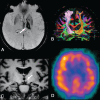Thalamic alexia with agraphia
- PMID: 22593808
- PMCID: PMC3349959
- DOI: 10.4081/ni.2012.e4
Thalamic alexia with agraphia
Abstract
Alexia with agraphia is defined as an acquired impairment affecting reading and writing ability. It can be associated with aphasia, but can also occur as an isolated entity. This impairment has classically been associated with a left angular gyrus lesion In the present study, we describe a case involving a patient who developed alexia with agraphia and other cognitive deficits after a thalamic hemorrhage. In addition, we discuss potential mechanisms of this cortical dysfunction syndrome caused by subcortical injury. We examined a patient who presented with alexia with agraphia and other cognitive deficits due to a hemorrhage in the left thalamus. Neuropsychological evaluation showed attention, executive function, arithmetic and memory impairments. In addition, language tests revealed severe alexia with agraphia in the absence of aphasia. Imaging studies disclosed an old thalamic hemorrhage involving the anterior, dorsomedial and pulvinar nuclei. Tractography revealed asymmetric thalamocortical radiations in the parietal region (left <right), and single photon emission computed tomography demonstrated hypoperfusion in the left thalamus that extended to the frontal and parietal cortices. Cortical cognitive deficits, including alexia with agraphia, may occur as the result of thalamic lesions. The probable mechanism is a diaschisis phenomenon involving thalamic tract disconnections.
Keywords: agraphia with alexia; diaschisis phenomenon; thalamic lesion; tract disconnection..
Conflict of interest statement
Authors disclosure: the authors have no conflicts of interest or funding to disclose.
Figures



References
-
- Leff AP, Behrmann M. Treatment of reading impairment after stroke. Curr Opin Neurol. 2008;21:644–8. - PubMed
-
- Sheldon CA, Malcolm GL, Barton JJ. Alexia with and without agraphia: an assessment of two classical syndromes. Can J Neurol Sci. 2008;35:616–24. - PubMed
-
- Dejerine J. Sur un cas de cécité verbale avec agraphia, suivi d' autopsie. Comp Rend Soc Biol. 1891;3:197–201.
-
- Geschwind N. Disconnexion syndromes in animals and man I. Brain. 1965;88:237–94. - PubMed
-
- Geschwind N. Disconnexion syndromes in animals and man II. Brain. 1965;88:585–644. - PubMed
Publication types
LinkOut - more resources
Full Text Sources

